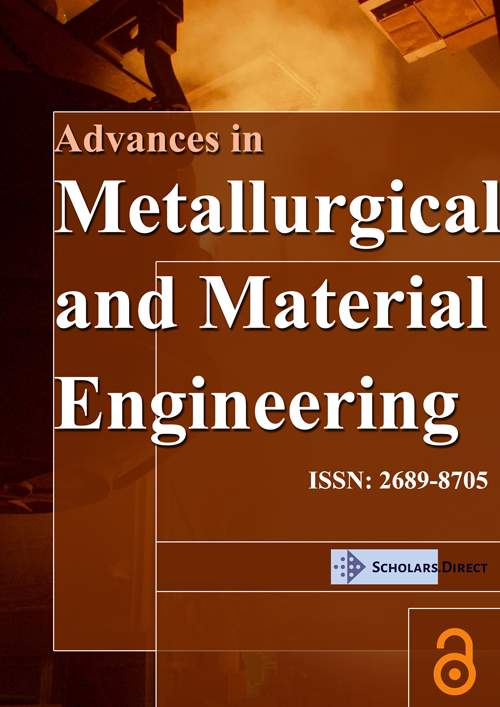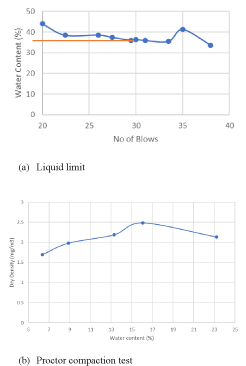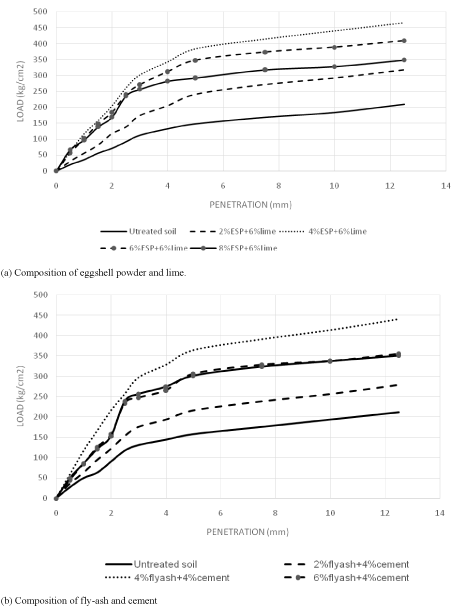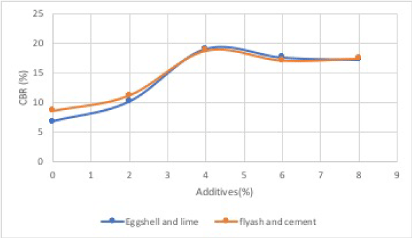Effects of Chemical Stabilisation of Eggshells-Lime and Fly-Ash-Cement on the Structural Strength of Subgrade Soil in Rural Roads
Abstract
This study examines the chemical compositions of eggshell powder (ESP) and lime as the soil stabilisers and compared with the compositions of cement and fly-ash to understand the optimal distribution of chemical stabilisers maximizing the bearing capacity and structural integrity of subgrade soil. Two chemical compositions of ESP-lime and fly-ash-cement with 2%, 4%, 6% and 8% of total mass of soil sample were mixed with 6% and 4% constant ratio of lime and cement, respectively. The soil samples were collected from three different points of unpaved roads in Gander bal district of Jammu & Kashmir State in India that experiences the seasonal variations resulting in uneven moisture distribution throughout the year. The CBR tests of both treated (chemical stabilisation) and untreated soils were performed followed the code of practices in Indian standards that is IS: 2720 1985.The combination of 4% ESP and 6% lime resulted in highest CBR value at 19.06%; and the combination of 4% fly-ash and 4% cement had the CBR value of 18.73%. The increase in bearing capacity of subgrade soil mixed with ESP and lime supports the pavement structure with less thickness resulting in the reduction of budgetary allocation for road construction, maintenance and rehabilitation operations.
Keywords
Chemical stabilisation, Eggshells, Fly-ash, Lime, Cement, California bearing ratio
Introduction
Rural road has played an important role in land use change and economic development; and the increasing demands related to rural economic growth have also highlighted shortfalls in the quantity and quality of rural roads [1-5]. The structural strength of rural road has direct and indirect effects at various extents on human activities and land uses in rural areas particularly with limited access of transport facilities [6]. Rural roads in developing countries are mostly unpaved. For example, 70% (1.9 million km) of rural roads in India are unpaved. Unsuitable and lack of maintenance of rural roads result in poor load bearing capacity of subgrade soil that is subject to farm-bound traffic flows and moisture contents. The State of Jammu and Kashmir in India has a wide variety of soil types that experience seasonal variations with heavy rains, winter and summers resulting in uneven moisture distribution throughout the year.
The uneven moisture distribution leads to poor quality of subgrade soil that is the main cause of poor condition of rural roads in the State of Jammu and Kashmir in India. The drained and undrained shear strength, maximum dry density, optimum moisture content, proportion of fine aggregates, Atterberg limits are the physical parameters that define the strength of subgrade soil. The soil compaction, reinforcements, pore water pressure reduction (dewatering) and chemical stabilisation are typically used to improve the shear strength parameters and bearing capacity of subgrade soils [7,8]. The methods of stabilisation, both mechanical and chemical, have significant impacts on settlement, shearing resistance, and bearing capacity of subgrade soil.
The most common chemical stabilisers are lime, cement and fly-ash, although there are other methods of soil stabilisations such as geo-textiles and fabrics, recycled waste, thermal and electrical stabilisations. Lime stabilisation is a historic technique for increasing flexible properties and strength of soil. Lime stabilisation that includes cation-exchange, flocculation, carbonation and pozzolanic response can change the plastic nature of soils, decrease the liquid limit and increase the soil strength [9,10]. Cement is also commonly used as a binding agent to strengthen the bearing capacity of soil by the process of cement hydration. Cement stabilisation process depends on soil types, proportion of cement-water contents, degree of mixing and time of curing [11].
Portland cement is effective for rural roads, in terms of compressive strength, durability, uniform load distribution, deflection reduction and resiliency to leaching over long-term period in stabilising both granulated and fine-grained soils; however, cement stabilisation reduces the permeability of subgrades soil and comparatively expensive [12-14]. Azadegan, et al. [7] investigated the soil stabilisation bycement kiln dust and fly ash (Class C) at five construction sites in Oklahoma and revealed that treated soils had 7 to 46 times resilient modulus than untreated soil. Similarly, Madhu, et al. [15] experimented that mixing 10% cement and 5% lime with soil increased the California Bearing Ratio (CBR) value by 15% to 25% at 2.5 mm penetration. Several studies examined the process of soil stabilisation using fly-ash (a fine residue of coal combustion in thermal power plants) classified as class F or class C [16-21]. Senol, et al. [18] investigateddifferent proportions of fly-ash (0%, 10%, 18%, and 30%) and water contents in soil stabilisation process and concluded that fly-ash enhanced the CBR value of soil with a range of 15% to 31%. Similarly, Hatipoglu, et al. [19] stated that stabilisation of road surface gravel in Minnesota with fly-ash increased the CBR value by 2 times. Prabakar, et al. [20] determiend that fly-ash decreased the dry density by 15% to 20%, and increased the void ratio and porosity in soil. For example, the void ratio was increased by 25% with the addition of up to 46% fly-ash in soil [20]. Fly-ash (particularly Class C) alsoincreases the structural strengh and stifness of subgrade soil [16,20]. Eggshell powder (ESP) iseco-friendly, economical and sustainable soil stabiliser that is available from kitchen waste without any cost and its production is very simple.
Various studies analysed the effect of ESP on the strength and durability of soil. Paul, et al. [22] investigated that ESP increased the optimum moisture content (OMC) and decreased the maximum dry density (MDD). Mn and Fo [23] argued that eggshell could be a potential replacment of cement stablised soil after observing the increase in soil strength with different proportion of eggshell powder mixed with cement stablised soil. Similarly, Ahmed, et al. [24,25] found that the optimum soil stabilisation with ESP could increase the CBR value by 11%. Some studies tested ESP as the partial replacement of soil cement stabilisation, while studies used the combination of cement and lime stabilisation.
Since rural roads in developing countries like India are deprived of infrastructure budget for periodic maintenance, a cost-effective solution for soil stabilistaiton can improve the condition of subgrade soil of unpaved roads. The 95% of eggshells is Calcium Oxide (CaO) while quick line is manufactured by transforming calcium carbonate (CaCO3)into CaO. A combination of low cost and easily availableeggshells and lime with similar chemical properites can enhance the soil stabilistion. This study examines the chemical compositions of ESP and lime as the soil stabilisers and compared with the compositions of cement and fly-ash to understand the optimal distribution of chemical stabilisers to maximise the bearing capacity of subgrade soil because ESP and lime are eco-friendly and least expensive stabilisers.
Methodology
The soil samples were collected from there points of unpaved roads in Gander bal district of Jammu & Kashmir State in India. The sample soils were mixed with chemical stabilisers and oven dried at the laboratory of Roads and Building Department in Srinagar, capital of Jammu & Kashmir State. This study followed the code of practices in Indian standards that is IS: 2720 1985 for carrying out the soil experiments. The sample soils were compacted using proctor standard tests to get optimum moisture content corresponding to maximum dry density. The index properties of sample soils such as liquid limit, plastic limit, and plasticity index were examined. The sample soils with optimum moisture content were taken to perform CBR test. The CBR tests of both treated (chemical stabilisation) and untreated soils were conducted under soaked condition and the specimen sweresoaked in water for 4 days. Eggshell powder (ESP) was mixed with lime (constant proportion 6% of total soil mass) at varying proportions such as 2%, 4%, 6% and 8% of total soil mass to analyse the optimum proportion of eggshell maximising the soil structural integrity. Similar proportions of fly-ash were mixed with cement (constant proportion 4% of total soil mass) to analyse the comparative effects of ESP-lime and fly-ash-cement on the soil stability. This study tested Class F fly-ash (consists of alumino-silicate glass mulita and magnetite) and quicklime as the chemical stabilisers. Liquid limit, plastic limit and CBR tests were performed to understand the soil stabilisation process. The Casagrande apparatus was used to determine liquid limit of soil.
The 120 grams of soil sample passing through 425-micron sieve was mixed with water to attain a uniform paste. The soil paste was placed in a cup and a sharp grove was made along the centreline. The cup was dropped from a height of about 1cm by rotating the crank at the rate of 2 revolutions/sec till two splits of soil get separated along 12 mm. Number of blows were recorded, and a representative sample of soil cake was collected and oven dried to determine moisture content. The moisture content corresponding to 25 blows was taken as Liquid limit of soil.
The soil samples of 20 grams passing through 425-micron sieve were mixed with distilled water in evaporating dishes to estimate the plastic limit of soils. An 8-gram ball of soil sample was rolled between fingers and a glass plate into a uniform thread. Rate of rolling was kept at 80 to 90 strokes per minute and continued till the thread reaches a diameter of 3 mm. Pieces of crumbled thread formed were put in a container to determine the moisture content. The average of trails was determined as the plastic limit of treated soils.
The standard proctor compaction test were performed to determine the optimum moisture content and dry density of soil. A soil sample of about 12-14 kg was mixed with 8% water and kept in an air tight container for about 18 hours. The soil sample was then divided into five equal parts and 2.5 kg of soil was taken in a tray. The diameter, height, volume and weight of moulds with base plate were recorded and the collar was attached. Soil was filed up to 1/3 height of moulds and compacted with 25 blows. The procedures were followed for the next two layers, collar was removed, and excess soil was trimmed using a straight edge. A sample soil was taken from the middle portion of compacted soil and mixed with 3% additional water. The process was repeated for 5 times to estimate the optimum water content maximising the dry density. The optimum water content of soil was used for CBR test.
According to Indian code IS 2720 (part 16), the standard penetration device is comprised of a mould with internal diameter 150 mm and a height of 175 mm; a detachable collar and a base plate having perforations at bottom; a spacer disk of 148 mm diameter and a height of 47.7 mm. The surcharge weights of mass 2 kg each and having a centre hole of 53 mm diameter and a slotted weight of 2.5 kg. A loading machine, capacity of 5000 kg, was equipped with a movable head and base travelling with a uniform rate of 1.25 mm/min. Test specimen for CBR test was prepared by dynamic compaction of 5 layers with 72 blows for each layer. The CBR values were investigated at 2.5 mm or 5 mm penetration for both untreated and treated soils (with different proportions of chemical stabilisers) to determine the subgrade soil's bearing capacity.
Results and Discussion
The liquid limit, plastic limit, standard proctor compaction and CBR tests were performed both for untreated and stabilised soil samples to understand the impact of chemical stabilisation on the physical properties of subgrade soil. The liquid limit or water content of untreated soil, estimated from the Casagrandeapparatus, is37 (Figure 1a). The plasticity index of untreated soil is 10 considering the plastic limit of soil as 27 that categorised the untreated soil as clay with low compressibility. The clay, gravel and sand ratio of untreated soil is 85:3:12. The compaction test estimated the optimum moisture content of untreated soil as 16% with a maximum dry density of 2.5 mg/m3 (Figure 1b). This optimum moisture content was used to estimate the soaked CBR values for treated soil mixed with chemical stabilisers.
The soaked CBR values for soils mixed with different proportions of chemical-stabiliser mixtures were investigated to achieve the optimum contents of chemical stabilisers that ensure the highest CBR values and bearing capacity of subgrade soils. Two chemical compositions of ESP-lime and fly-ash-cement with 2%, 4%, 6% and 8% of total mass of soil sample were mixed with 6% and 4% constant ratio of lime and cement to understand the comparative impacts of ESP and fly-ash on the structural integrity of subgrade soil, respectively. During the penetration test, the penetration piston is forced into the soil samples at a constant loading rate. The load-penetration curves for different proportions of chemical stabilisers mixed with soil samples were obtained observing the displacement and contact force of soil's wall (Figure 2a and Figure 2b).
The CBR values of sample soils for different proportions of chemical stabilisers were calculated from the correlated unit test load values corresponding to 2.5 mm and 5 mm penetration from the load-penetration curve (Figure 3). Since the CBR values at 2.5 mm penetration were higher than that of 5 mm penetration, CBR values at 2.5 mm penetration were compared for soil samples mixed with different proportions of chemical stabilisers (Figure 3). The CBR value for untreated soil at 2.5 mm penetration was found to be 6.73%. Figure 3 shows that CBR values were increased with addition of both compositions of chemical stabilisers but started to decrease after more than 4% of total mass of soil samples. The optimum proportion of ESP and fly-ash in both chemical stabilisation processes is 4%. The ESP and fly-ash have no significant influences on the CBR numerical results as additive materials when their proportions exceed 4% of total mass of soil.
The CBR value for soil mixed ESP and lime was highest (19.06%) for a mixture of 4% ESP and 6% lime. Similarly, the highest value (18.73%) of CBR for treated soil was achieved with a composition of 4% fly-ash and 4% cement. The CBR value remains constant after reaching the highest value despite addition of ESP and fly-ash in the soil samples (Figure 3). Moreover, the CBR values were almost similar for both chemical compositions of soil stabilisers. This investigation reveals that using the same proportion (4%) of ESP and lime as additive materials for soil, the subgrade soil of rural roads can achieve the equivalent bearing capacity with that mixed with fly-ash and cement. The chemical composition of ESP and lime is eco-friendlier, and the egg shells can be collected from the kitchen waste almost free of costs.
Conclusions
The methods of soil stabilisation, both mechanical and chemical, have significant impacts on the settlement, shearing resistance, and bearing capacity of subgrade soil. The most common chemical stabilisers are lime, cement and fly-ash, although there are other methods of soil stabilisation such as geo-textiles and fabrics, recycled waste, and thermal and electrical stabilisations. This study examines the chemical compositions of ESP and lime as the soil stabilisers and compared with the compositions of cement and fly-ash to understand the optimal distribution of chemical stabilisers to maximise the bearing capacity of subgrade soil because ESP and lime are eco-friendly and least expensive stabilisers.
The ESP was mixed with lime (constant proportion 6% of total soil mass) at varying proportions such as 2%, 4%, 6% and 8% of total soil mass to analyse the optimum proportion of eggshell maximising the soil structural integrity. Similar proportions of fly-ash were mixed with cement (constant proportion 4% of total soil mass) to analyse the comparative effects of ESP-lime and fly-ash-cement on the soil stability. The soil samples were collected from three different points of unpaved roads in Gander bal district of Jammu & Kashmir State in India that experiences the seasonal variations with heavy rains, winter and summers resulting in uneven moisture distribution throughout the year. The CBR tests of both treated (chemical stabilisation) and untreated soils were performed followed the code of practices in Indian standards that is IS: 2720 1985.
The laboratory investigation reveals that ESP and fly-ash can be used as the activators for lime and cement in improving strength properties of subgrade soil, respectively. The combination of 4% ESP and 6% lime resulted in highest CBR value at 19.06%. on the other hand, the chemical stabilisation with 4% fly-ash and 4% cement provides the CBR value of 18.73%. The increase in bearing capacity of subgrade soil supports the thickness reduction of pavement structure resulting in less budgetary allocation for road construction, maintenance and rehabilitation operations. In addition, chemical stabilization of soil with ESP and lime is more economical and eco-friendlier comparing to the production of other chemical stabilisers. Eggshells are produced in large quantities mostly from restaurants and hotels, and there is a disposal problem in developing countries.
The use of ESP as the additive material of subgrade soil not only improve the bearing capacity of subgrade soil but also reduces the construction and maintenance costs of pavement structure as well as handling and recycling costs of food waste. This study only investigated the ESP and fly-ash combined with lime and cement, respectively. There is a scope for comparative investigation on other stabilisers such as plastic bags, geo-synthetics, geo-fibers and geo-polymers that can be used for stabilisation process.
The experiments were performed in a controlled environment with no variation in temperature. Future studies should investigate the chemical stabilisation of soil with seasonal variations and different temperatures. The CBR tests were performed on soil samples with optimum moisture content that is not feasible during the road construction projects. Further experiments such as unconfined compressive strength test, swelling, permeability and porosity of subgrade soil require to be investigated to understand the impacts of seasonal and temperature variations. The sample subgrade soils examined in this study were clay with low compressibility. The impacts of chemical compositions of ESP-lime and fly-ash-cement require to be investigated for other types of subgrade soil such as sandy, silty, and loamy.
References
- Jaarsma CF (1997) Approaches for the planning of rural road networks according to sustainable land use planning. Landscape and Urban Planning 39: 47-54.
- Jones S (2004) Contribution of infrastructure to growth and poverty reduction in East Asia and the pacific. Background paper. Oxford, UK: Oxford Policy Management.
- Wilson GW (1973) Towards a theory of transport and development. In: Hoyle BS (edn), Transport and Development. Macmillan, London, 208-230.
- Banister D, Berechman Y (2003) Transport investment and economic development. (2nd edn), Routledge, London.
- Olsson J (2009) Improved road accessibility and indirect development effects: Evidence from rural Philippines. Journal of Transport Geography 17: 476-483.
- Plessis Fraissard M (2007) Planning roads for rural communities. Transportation Research Record: Journal of the Transportation Research Board 1989: 1-8.
- Azadegan O, Yaghoubi E, Li J (2013) Evaluation of the performance of lime and cement treated base layers in unpaved roads. Electronic Journal of Geotechnical Engineering 18: 647-660.
- Afrin H (2017) A review on different types soil stabilization techniques. International Journal of Transportation Engineering and Technology 3: 19-24.
- Bell FG (1996) Lime stabilization of clay minerals and soils. Engineering Geology 42: 223-237.
- Consoli NC, De Silva Lopes Jr L, Prietto PDM, et al. (2011) Variables controlling stiffness and strength of lime-stabilized soils. Journal of Geotechnical and Geoenvironmental Engineering 137.
- Makusa GP (2012) State of the art review: Soil stabilization methods and materials in engineering practice. Luleå, Sweden: Luleå University of Technology 35.
- Little D, Males E, Prusinski J, et al. (2000) Cementitious Stabilization. Transportation in the Millenium 1-7.
- Pandey A, Rabbani A (2017) Soil stabilisation using cement. International Journal of Civil Engineering and Technology 8: 316-322.
- Prasad ACSV, Reddy CNVS (2015) Strength characteristics of cement stabilized. Proceedings of 50th Indian Geotechnical Conference, 17-19 December, Pune, India.
- Madhu A, Pawar A, Kumar A, et al. (2018) Stabilization of rural road subgrade using soil-cement. International Journal of Research in Engineering, Science and Management 1: 98-101.
- Edil T, Benson C, Bin Shafique M, et al. (2002) Field evaluation of construction alternatives for roadways over soft subgrade. Transportation Research Record: Journal of the Transportation Research Board 1786: 36-48.
- Sudhir M, Swami RK, Uma A (2012) Lime/cement stabilisation for soil and granular materials. Workshop on Non-Conventional Materials/Technologies. Technical Papers 56-74.
- Senol A, Edil TB, Bin Shafique MS, et al. (2006) Soft subgrades stabilization by using various fly ashes. Resources, Conservation and Recycling 46: 365-376.
- Hatipoglu B, Edil TB, and Benson CH (2008) Evaluation of base prepared from road surface gravel stabilized with fly ash. Proceedings of Geo Congress 2008, New Orleans, USA, 288-295.
- Prabakar J, Dendorkar N, Morchhale RK (2004) Influence of fly ash on strength behavior of typical soils. Construction and Building Materials 18: 263-267.
- Parsons RL, Kneebone E (2005) Field performance of fly ash stabilised subgrades. Proceedings of the Institution of Civil Engineers Ground Improvement 9: 33-38.
- Paul A, Anumol VS, Moideen F, et al. (2014) Studies on improvement of clayey soil using egg shell powder and quarry dust. International Journal of Engineering Research and Applications 4: 55-63.
- Mn M, Fo O (2018) Effect of egg shell powder (ESP) on the strength properties of cement-stabilization on olokoro lateritic soil. Open Access Journal of Waste Management & Xenobiotics 1: 000103.
- Ahmed B, Rahman A, Das J (2016) Eggshell powder utilization as CBR modifying agent to improve the subgrade soil. Proceedings of the 3rd International Conference on Civil Engineering for Sustainable Development, 12-14 February, Khulna, Bangladesh, 1121-1126.
- Prusinski J, Bhattacharja S (1999) Effectiveness of portland cement and lime in stabilizing clay soils. Transportation Research Record: Journal of the Transportation Research Board 1652: 215-227.
Corresponding Author
Dr. Shohel Amin, Lecturer in Civil Engineering (Highways & Transportation Engineering), Research Associate, Institute of Future Transport and Cities Faculty of Engineering, Environment & Computing Coventry University, Priory St, Coventry, West Midlands, CV1 5FB, United Kingdom, Tel: +442-477-650-892.
Copyright
© 2022 Khan MS. This is an open-access article distributed under the terms of the Creative Commons Attribution License, which permits unrestricted use, distribution, and reproduction in any medium, provided the original author and source are credited.







